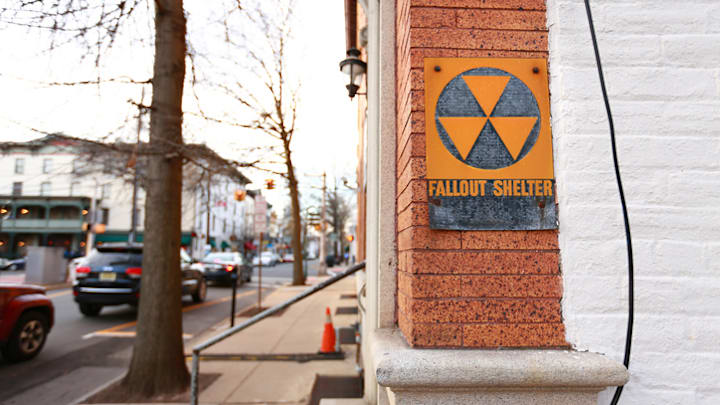Caldwell Elementary School in McKinney, Texas, northeast of Dallas, looks like a typical 1940s-era brick school building. But it served a critical role in mid-century America: If a nuclear attack occurred, the people of McKinney could seek refuge from radioactive fallout in its basement.
The faded “fallout shelter” sign with three yellow triangles above the door is one of tens of thousands still visible on building façades today. They serve as a grim reminder of the hottest flashes of the Cold War. So why are they still around?
“Follow the Arrows”
As Washington and Moscow pushed the world to the nuclear brink in the early 1960s, fallout shelter signs became a common part of the American landscape. On July 25, 1961, President John F. Kennedy said in a televised address that the United States had a moral obligation to protect its people from nuclear threat. “To recognize the possibilities of nuclear war in the missile age, without our citizens knowing what they should do and where they should go if bombs begin to fall, would be a failure of responsibility,” he said, before announcing a plan to establish public fallout shelters across the country.
By September that year, representatives of the National Shelter Program were hard at work identifying suitable public spaces in existing buildings and stocking them with essential survival supplies. (The keyword here is public: The U.S. already counted a significant number of shelters, but they were privately owned and inaccessible to most people.) Each shelter that could house 50 or more people was marked with the National Fallout Shelter Sign, unveiled by the Department of Defense’s Office of Civil Defense on December 1, 1961.
“Follow the arrows,” a photo caption in the Los Angeles Times read, introducing readers to a symbol that would soon become as recognizable as the golden arches or Uncle Sam’s pointed finger. A press release from the Office of Civil Defense described the sign as a yellow background with a black circle and three yellow triangles inside the circle above the words FALLOUT SHELTER. “The color combination, yellow and black, is considered as the most easily identified attention getter by psychologists in the graphic arts industry,” the release claimed.

By 1964, the program had created enough shelters to house 120 million people—far exceeding its initial 20 million target. Fallout shelters came in all kinds of shapes and sizes. Some were built and managed directly by the government, while others were licensed to third parties. As outlined in the program’s directive, every shelter needed to have a minimum carrying capacity of 50 individuals, 10 square feet of floor space if the facility was properly ventilated, and 500 cubic feet if it was not.
To facilitate new construction, the Defense Department created annual awards for architectural firms that incorporated shelters into their buildings. The Pentagon also conducted surveys to see which buildings were most resistant to radiation, with dams, tunnels, caves, and even the upper floors of high-rise buildings found to be safe places to sit out nuclear fallout.
Fallout Shelter vs. Bomb Shelter
Contrary to popular belief, none of these shelters was capable of protecting people from a nuclear blast. It could only insulate them from the resulting radiation. If your town were struck by an atomic bomb, there was no saving you. If, however, you lived somewhere else—ideally far, far away from the impact—your neighborhood shelter could theoretically protect you from radiation poisoning.
That is, as long as you stayed inside. Scientists from the International Commission on Radiological Protection advised a minimum waiting period of 48 hours, roughly how long it takes for acutely dangerous levels of radiation to drop to moderately dangerous ones. Just in case, though, the National Shelter Program made sure each facility was provided with at least two weeks’ worth of supplies, including non-perishable foods, water, medical kits, and radiation detectors.
The National Shelter Program gradually scaled back its operations in the 1970s and 1980s as the U.S. and Soviet Union pivoted from nuclear brinkmanship to de-escalation and, finally, disarmament following the 1987 Intermediate-Range Nuclear Forces Treaty. Without additional federal funding for dismantling the shelters, most municipalities left their facilities as-is—complete with the National Fallout Shelter Signs above the doors as inadvertent reminders of a bygone time.
Discover More Stories from the Atomic Age:
